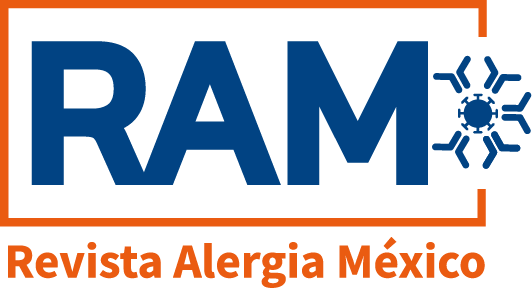Resumen
Antecedentes: Las reacciones de hipersensibilidad perioperatorias constituyen un problema de salud mundial, con una incidencia estimada de uno por cada 100 000 procedimientos y una tasa de mortalidad de 0.1 a 9 %. Los principales factores de riesgo son antecedentes de alergia a otros fármacos, atopia, trastornos psiquiátricos asociados y cirugías previas.
Objetivos: Determinar la frecuencia de sensibilización y tipo de medicamentos implicados en la alergia perioperatoria en un hospital de tercer nivel, durante tres años.
Método: Estudio retrospectivo, transversal, descriptivo de alergia perioperatoria corroborada mediante pruebas cutáneas a cada medicamento y al látex, de pacientes atendidos en el Servicio de Alergia e Inmunología Clínica del Hospital General de México.
Resultados: Se incluyeron 28 pacientes con el diagnóstico de alergia perioperatoria. Los principales desencadenantes fueron los bloqueadores neuromusculares (46.42 %), el látex (28.52 %) y el propofol (14.28 %). El principal factor de riesgo fue el antecedente de cirugías previas (89.28 %). En su mayoría, las reacciones de alergia perioperatoria fueron leves (71.42 %) y se presentaron en el periodo posoperatorio (60.71 %).
Conclusiones: El diagnóstico y tratamiento iniciales siempre deberán efectuarse por el médico anestesiólogo o el cirujano, enfocados en el retiro de los posibles agentes causales.
Referencias
Laxenaire MC, Mertes PM, Benabes B. Anaphylaxis during anaesthesia: results from a two-year survey in France. Br J Anaesth. 2001;87(4):549-558. DOI: 10.1093/bja/87.4.549
Krøigaard M, Garvey LH, Menné T, Husum B. Allergic reactions in anaesthesia: are suspected causes confirmed on subsequent testing? Br J Anaesth. 2005;95(4):468-471. DOI: 10.1093/bja/aei198
Volcheck GW, Mertes PM. Local and general anesthetics immediate hypersensitivity reactions. Immunol Allergy Clin North Am. 2014;34(3):525-546. DOI: 10.1016/j.iac.2014.03.004
Lobera T, Audicana MT, Pozo MD, Blasco A, Fernández E, Canada P, et al. Study of hypersensitivity reactions and anaphylaxis during anesthesia in Spain. J Investig Allergol Clin Immunol. 2008;18(5):350-356.
Berroa F, Lafuente A, Javaloyes G, Cabrera-Freitag P, de la Borbolla JM, Moncada R et al. The incidence of perioperative hypersensitivity reactions: a single-center, prospective, cohort study. Anesth Analg. 2015;121(1):117-123. DOI: 10.1213/ANE.0000000000000776
Edwards IR, Aronson JK. Adverse drug reactions: definitions, diagnosis, and management. Lancet. 2000;356(9237):1255-1259. DOI: 10.1016/S0140-6736(00)02799-9
Muñoz-Cano R, Picado C, Valero A, Bartra J. Mechanisms of anaphylaxis beyond IgE. J Investig Allergol Clin Immunol. 2016;26(2):73-82. DOI: 10.18176/jiaci.0046
Peavy RD, Metcalfe DD. Understanding mechanisms of anaphylaxis. Curr Opin Allergy Clin Immunol. 2008;8(4):310-315. DOI: 10.1097/ACI.0b013e3283036a90
Golden D, Wallace DV, Bernstein J, Dinakar C, Greenhawt M, Khan DA, et al. The diagnosis and management of anaphylaxis: an updated practice parameter. J Allergy Clin Immunol. 2005;115(3 Suppl 2):S483-S523. DOI: 10.1016/j.jaci.2005.01.010
Levy JH, Yegin A. Anaphylaxis: what is monitored to make a diagnosis? How is therapy monitored? Anesthesiol Clin North Am. 2001;19(4):705-715. DOI: 10.1016/S0889-8537(01)80008-0
Ebo DG, Fisher MM, Hagendorens MM, Bridts CH, Stevens WJ. Anaphylaxis during anaesthesia: diagnostic approach. Allergy. 2007;62(5):471-487. DOI: 10.1111/j.1398-9995.2007.01347.x
Brockow K, Garvey LH, Aberer W, Atanaskovic-Markovic M, Barbaud A, Bilo MB, et al. Skin test concentrations for systemically administered drugs: an ENDA/EAACI Drug Allergy Interest Group position paper. Allergy. 2013;68(6):702-712. DOI: 10.1111/all.12142
Aberer W, Bircher A, Romano A, Blanca M, Campi P, Fernández J, et al. Drug provocation testing in the diagnosis of drug hypersensitivity reactions: general considerations. Allergy. 2003;58(9):854-863. DOI: 10.1034/j.1398-9995.2003.00279.x
Brown SG, Mullins RJ, Gold MS. Anaphylaxis: diagnosis and management. Med J Aust. 2006;185(5):283-289.
Simons FER, Ardusso LRF, Bilò MB, Dimov V, Ebisawa M, El-Gamal YM, et al. World Allergy Organization guidelines for the assessment and management of anaphylaxis. World Allergy Organ J. 2011;4(2):13-37. DOI: 0.1097/WOX.0b013e318211496c
Simons FE, Ardusso LR, Bilò MB, Cardona V, Ebisawa M, El-Gamal YM, et al. International consensus on (ICON) anaphylaxis. World Allergy Organ J. 2014;7(1):9. DOI: 10.1186/1939-4551-7-9
Campbell RL, Li JTC, Nicklas RA, Sadosty AT, Bernstein D, Blessing-Moore J, et al. Emergency department diagnosis and treatment of anaphylaxis: a practice parameter. Ann Allergy Asthma Immunol. 2014;113:599-608. DOI: 10.1016/j.anai.2014.10.007
Mirakian R, Ewan PW, Durham SR, Youlten LJ, Dugué P, Friedmann PS, et al. BSACI guidelines for the management of drug allergy. Clin Exp Allergy. 2009;39(1):43-61. DOI: 10.1111/j.1365-2222.2008.03155.x
Muraro A, Roberts G, Worm M, Bilò MB, Brockow K, Fernández Rivas M, et al. Anaphylaxis: guidelines from the European Academy of Allergy and Clinical Immunology. Allergy. 2014;69(8):1026-1045. DOI: 10.1111/all.12437

Esta obra está bajo una licencia internacional Creative Commons Atribución-NoComercial 4.0.
Derechos de autor 2018 Revista Alergia México





